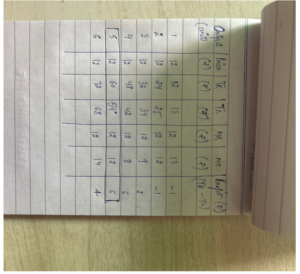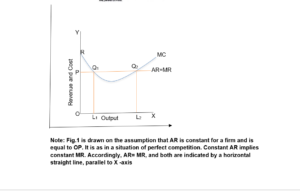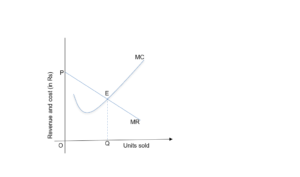Producer’s equilibrium when the price is constant
Firms can sell any quantity of output at the market-determined price when the price remains constant. Price or AR stays the same at every output level. Additionally, every additional unit’s (MR) revenue is equivalent to AR. It indicates that the AR curve and the MR curve are identical.
After the MC-MR output level, the producer aims to produce that level of output at which MC equals MR and is greater than MR.
Let us use the Table to understand this, where the market price is set at 12 per unit.

Firms can sell any quantity of output at the market-determined price when the price remains constant. Price or AR stays the same at every output level. Additionally, every additional unit’s (MR) revenue is equivalent to AR. It indicates that the AR curve and the MR curve are identical.
After the MC-MR output level, the producer aims to produce that level of output at which MC equals MR and is greater than MR.
Let us use the Table to understand this, where the market price is set at 12 per unit.

The X-axis depicts output, while the Y-axis depicts revenue and expenses. Curves for MR and AR are both straight lines that run parallel to the X-axis. The shape of the MC curve is U. Because only at point Q2 do the following two conditions exist, the producer’s equilibrium will be determined at the OL2 level of output that corresponds to point Q2
- MC MR; and
- After the MC-MR output level, MC is greater than MR.
However, even though MC-MR is satisfied at point L1, this is not the point of equilibrium because it only meets the first condition. Therefore, when both conditions are met, the producer will be in equilibrium.
Relation between Price and MC at Equilibrium
The price or AR and MR will be equal if the price stays the same at all output levels.
Price is equivalent to the MC at the equilibrium level when MC=MR is achieved.
Producers’ Equilibrium when Price Isn’t Constant (When Price Falls with Increase in Output)
- The MR curve slopes downward when there is no fixed price and when the price falls with an increase in output.
- The goal of producers is to achieve an output level at which MC and MR are equal and the MC curve cuts the MR curve from below.

At the 3rd unit, both equilibrium conditions are met, as shown in Table. When more output is produced after three units of output, MC equals MR and is higher than MR.
At three output units, Producer’s Equilibrium will be reached.

The X-axis of the figure depicts output, while the Y-axis depicts revenue and expenses. At the OQ level of output that corresponds to point E, the producer will reach equilibrium because the following two conditions are satisfied:
- MC=MR
- After MC = MR output level, MC is greater than MR.
The relationship between price and MC at equilibrium (when the price falls with increased output).
- Price (or AR)>MR
- Since equilibrium is reached when MC=MR, this indicates that the price is greater than MC at the equilibrium level.